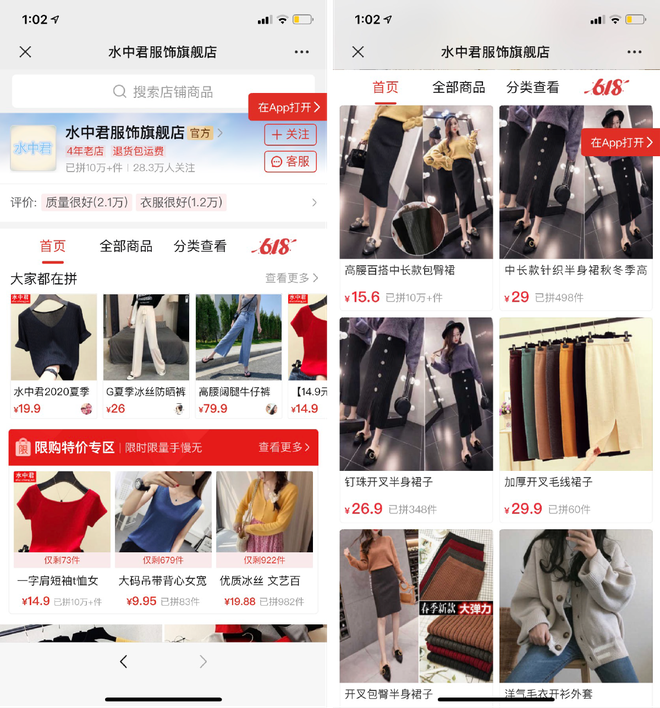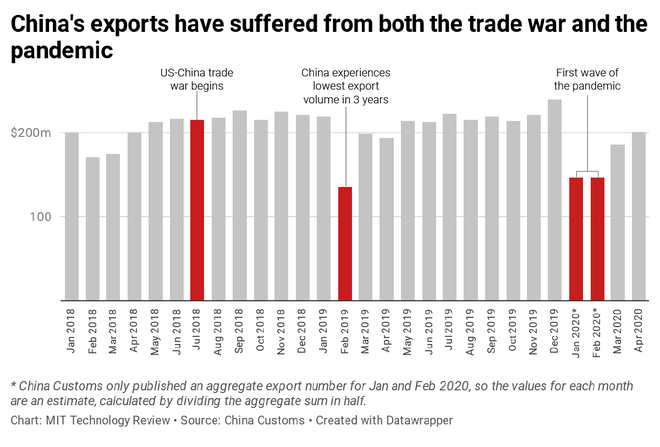This is the exit for Chinese manufacturers in the context of trade wars and pandemics
- Tram Ho
Zhu Kaiyu opened a knitwear factory in Dongguan, Guangdong Province, China in 2020. So far, the situation of this production facility is quite impressive: 15,000 square meters, 800 employees, 300 machines, 5 million clothes are sold every year. He is also proud to be a reliable manufacturing partner for foreign companies such as Fullbeauty Brand, owner of a range of American brands of men’s and women’s apparel.
“It’s normal every year,” he said, “30% of my sales come from abroad.”
But everything has stopped since 2018. Across the textile industry, the U.S.-China trade war has started to strain the garment manufacturers, as it is one of the manufacturing industries. subjected to the greatest dependence on Chinese exports. Orders delayed shipping for up to three months, causing direct loss of Zhu’s revenue and congestion of storage systems because inventory could not be controlled.
Then, before the business fully recovered, Covid-19 appeared and “ripped” the world. The wobbly export resulted in Zhu canceling an order flow estimated at USD 4 to 5 million. Domestic sales were also affected when local stores were forced to close for the purpose of controlling the pandemic.
“The impact can be huge,” he said. “My factory is very big. I have a lot of workers who need support.”
But fortunately, Zhu had another sales channel. In 2018, Pinduoduo, an e-commerce giant targeting consumers in small Chinese cities, launched an initiative to connect manufacturers with the domestic market. Following the so-called “model that connects consumers with manufacturers, the platform begins to use its massive AI data and data warehouse to help Chinese manufacturers anticipate their interests.” consumers, thereby developing brands exclusively for domestic customers.

Kaiyu’s shop on Pinduoduo.
Pinduoduo not only tells manufacturers how to customize their products to fit market trends, it also advises them on how to redesign the packaging, how to set prices and how to market goods. online. In this way, manufacturers can improve their production efficiency, thereby making the product cheaper for consumers. And the platform can make money from new users with ads. This has helped both the platform and manufacturers gain access to a rapidly growing middle-class consumer base in China. Because while upstream consumers are more interested in international brands, this newer wave of consumers is more interested in good quality products at lower prices.
When the pandemic struck, Pinduoduo quickly expanded his initiative. It has added new incentives for affected producers to join its platform, welcoming them by adopting a livestream service, and organizing promotional sales events.
Therefore, Zhu joined with his own brand, named shui zhong Jun . He followed the platform’s guidelines and set up a live broadcast channel. Since May, he has been able to sell up to 25,000 clothing items through a livestream within hours, up from an average of 1,000 items a day.
The C2M (consumer-to-manufacturer) model initially appeared as a way to promote and modernize the manufacturing industry, attracting more consumers on Pinduoduo’s platform. But the trend has accelerated and brought new meaning, since the prolonged trade war and pandemic.
As China’s access to international markets has become increasingly unreliable, the country has increasingly sought to boost domestic consumption in an effort to prevent a potential economic recession.
“The problem is that China is losing a large amount of demand overseas,” said Derek Scissors, a resident scholar at the American Enterprise Institute, where he studies US-China trade and relations policies. . “They want to replace it with Chinese needs.”

Chart of Chinese exports from the middle of the trade war to the Covid-19 pandemic.
Like Pinduoduo, other Chinese e-commerce giants, including Alibaba-owned Taobao and JD, now offer C2M services. Since the beginning of this year, all three have set new goals to expand their C2M initiatives. Pinduoduo helped launch 106 manufacturer-owned brands in 2019, and their goal is to establish 1,000 new brands this year. It also signed a strategic partnership in April with the Dongguan government, which houses Zhu’s factory, one of China’s largest manufacturing centers.
Taobao, likewise, has pledged to bring at least $ 14 million to 1,000 manufacturers, distributed over 10 plant clusters, over the next three years. In March, it launched a new application called “Taobao Agreement” to introduce lower-price products designed through the C2M partnership.
JD said it will recruit partners on more than 100 industrial belts. In April, they also launched an “From Export to Domestic” initiative through the new application Jingxi to allow manufacturers to open new stores on their platform for free, then join engage in marketing, logistics and delivery services.
In 2018, the C2M model generated about $ 2.5 billion in sales in China, according to market research firm iReseach. It is estimated that it will increase to 5.9 billion USD by 2022.
And when the partnerships have produced promising results, manufacturers have also doubled their domestic branding strategies. Chen Zhuoyue, owner of a toy manufacturing company based in Chenghai, Guangdong, joined the JD’s C2M program in 2018. After JD helped customize the products and developed a strategy New prices, the business on this platform has rapidly grown to account for 50% of Chen’s domestic sales. When the pandemic hit and exports plummeted from 30% to less than 5% of sales, he took it as a sign to open two new stores on JD and launch more local brands.
Of course, it is not that Chen will stop working with foreign brands. In his opinion, this is just a measure to expand to more markets.
“If exports return to normal and long-term foreign collaborators knock at the door, I will be ready to continue to fulfill their orders , “ he said. For now, with the launch of his own brand, Chen sees this as an important source of growth and stability. “My plan is to expand my domestic presence , “ he said. “This year I want to increase investment in this sector.”

Is C2M a way out of the economic crisis?
According to iReseach , it is still not clear whether China’s domestic market alone can compensate for the changes from the international market in the long run. However, the country’s middle class has rapidly increased spending power and is expected to help increase the market size to US $ 141 million by 2022.
“Even before the pandemic, the country’s manufacturing industry had been struggling with too much supply,” according to Derek Scissors. “And they have relied on the United States and other foreign markets to eliminate their excess production.”
However, this expert does not believe that a new model like C2M will solve such profound macroeconomic problems. According to him, C2M is simply a “wise push” from e-commerce giants to increase their own profits.
However, this move has continued to emphasize China’s growing domestic market focus, as it seeks to build economic and technological self-sufficiency. For individual manufacturers like Zhu, the C2M model has certainly given him a more “resilient” feeling. And if even more unpredictable external factors occur, like another trade war, he will continue to invest in the C2M partnership with Pinduoduo.
“We will improve our products, research and development and production,” he said. “We will continue to build our own brand.”
Refer to technologyreview
Source : Genk
